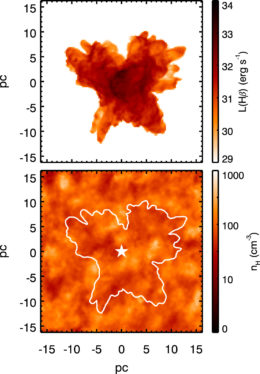Researchers have modeled the turbulent gas of the interstellar medium in a new way, with important implications for how we interpret observations of distant galaxies.
Probing the Early Universe

How can we tell what makes galaxies billions of light-years away shine? Astronomers use photoionization models to analyze the photons we collect from galaxies in the early universe and discern what sources of energy, like young stars, shocks, or active galactic nuclei, make them glow.
In a recent study, a team led by Yifei Jin used photoionization models — with a turbulent twist — to simulate the intricate emission nebulae that surround young, massive stars in galaxies near and far.
Forming Fractal Gas

Jin and collaborators used state-of-the-art models to simulate realistic emission nebulae from turbulent interstellar gas. The team placed a synthetic O star a million times more luminous than the Sun at the center of a cube 140 light-years on each side. They filled the cube with gas with an average density of 100 particles per cubic centimeter — a typical value for nebulae in the Milky Way — and the same chemical composition as the Sun.
The main advance in this work is the use of a fractal density pattern for the simulated interstellar gas. Unlike previous models, which assumed that the gas had the same density throughout, the team’s model incorporates density variations on large and small scales, resulting in a clumpy interstellar medium similar to what is seen in observations. As high-energy photons from the synthetic O star ionize the gas, they create an emission nebula with a complex and irregular shape.
Volume versus Boundary

To determine the properties of their modeled nebula, Jin and collaborators tracked the strength of the emission lines and categorized each emission line as either a volume species or a boundary species, depending on where in the nebula the line was produced. The volume species — H-alpha, H-beta, and [O III] — are produced mainly in the body of the nebula, while the boundary species — [O I], [S II], and [N II] — are produced along the outer edge.
By comparing against a modeled spherical nebula formed in a region of uniform gas, the team found that the more complex the structure of the nebula, the more prominent the emission from the boundary species. This effect becomes more important the more concentrated an emission line is toward the edge of the nebula; for instance, H-alpha emission is scarcely different between the two models, but [O I] emission — 99.5% of which is produced along the boundary of the nebula — soars by 253% when a realistic nebular shape is adopted.
This study by Jin and collaborators demonstrates that modeling turbulent interstellar gas in a realistic way can have a huge impact on the resultant emission lines — which in turn has implications for how we interpret emission lines from distant galaxies. The team predicts that using fractal geometry for models of interstellar gas will be key to interpreting observations of galaxies early in the universe, when interstellar gas was likely highly turbulent.
